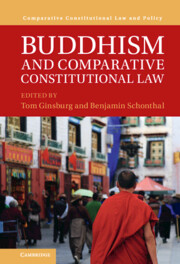217 results
The Entrenchment of Democracy
- The Comparative Constitutional Design of Elections, Parties and Voting
- Coming soon
-
- Expected online publication date:
- November 2024
- Print publication:
- 30 November 2024
-
- Book
- Export citation
25 - Contrariness and Contradiction in Constitutional Law
- from Part IV - Emerging Trends
-
-
- Book:
- Deciphering the Genome of Constitutionalism
- Published online:
- 14 March 2024
- Print publication:
- 21 March 2024, pp 330-344
-
- Chapter
- Export citation
The Long Hand of Anti-Corruption: Israeli Judicial Reform in Comparative Perspective
-
- Journal:
- Israel Law Review / Volume 56 / Issue 3 / November 2023
- Published online by Cambridge University Press:
- 06 October 2023, pp. 385-396
- Print publication:
- November 2023
-
- Article
-
- You have access
- Open access
- HTML
- Export citation
It’s the procedures, stupid: The success and failures of Chile’s Constitutional Convention
-
- Journal:
- Global Constitutionalism / Volume 13 / Issue 1 / March 2024
- Published online by Cambridge University Press:
- 13 September 2023, pp. 182-191
-
- Article
-
- You have access
- Open access
- HTML
- Export citation
4 - The Institutional Context of the International Court of Justice
- from Part I - The Role of the ICJ
-
-
- Book:
- The Cambridge Companion to the International Court of Justice
- Published online:
- 18 May 2023
- Print publication:
- 06 April 2023, pp 86-100
-
- Chapter
- Export citation
4 - Constitutional Design Options for Territorial Cleavages in the Middle East
- from Part I - Theoretical and Comparative Context
-
-
- Book:
- Federalism and Decentralization in the Contemporary Middle East and North Africa
- Published online:
- 15 January 2023
- Print publication:
- 05 January 2023, pp 67-83
-
- Chapter
- Export citation
The Pragmatics of Democratic “Front-Sliding”
-
- Journal:
- Ethics & International Affairs / Volume 36 / Issue 4 / Winter 2022
- Published online by Cambridge University Press:
- 22 December 2022, pp. 437-453
-
- Article
-
- You have access
- Open access
- HTML
- Export citation
Notes on Transliteration and Language
-
- Book:
- Buddhism and Comparative Constitutional Law
- Published online:
- 18 November 2022
- Print publication:
- 01 December 2022, pp xix-xx
-
- Chapter
-
- You have access
- Open access
- HTML
- Export citation
Contents
-
- Book:
- Buddhism and Comparative Constitutional Law
- Published online:
- 18 November 2022
- Print publication:
- 01 December 2022, pp vii-x
-
- Chapter
-
- You have access
- Open access
- HTML
- Export citation
Contributors
-
- Book:
- Buddhism and Comparative Constitutional Law
- Published online:
- 18 November 2022
- Print publication:
- 01 December 2022, pp xi-xii
-
- Chapter
-
- You have access
- Open access
- HTML
- Export citation
Part V - Comparative Perspectives
-
- Book:
- Buddhism and Comparative Constitutional Law
- Published online:
- 18 November 2022
- Print publication:
- 01 December 2022, pp 343-344
-
- Chapter
-
- You have access
- Open access
- HTML
- Export citation
1 - Introduction
-
-
- Book:
- Buddhism and Comparative Constitutional Law
- Published online:
- 18 November 2022
- Print publication:
- 01 December 2022, pp 1-32
-
- Chapter
-
- You have access
- Open access
- HTML
- Export citation
Acknowledgments
-
- Book:
- Buddhism and Comparative Constitutional Law
- Published online:
- 18 November 2022
- Print publication:
- 01 December 2022, pp xvii-xviii
-
- Chapter
-
- You have access
- Open access
- HTML
- Export citation
Copyright page
-
- Book:
- Buddhism and Comparative Constitutional Law
- Published online:
- 18 November 2022
- Print publication:
- 01 December 2022, pp vi-vi
-
- Chapter
-
- You have access
- Open access
- HTML
- Export citation
Part I - Religious and Political Underpinnings
-
- Book:
- Buddhism and Comparative Constitutional Law
- Published online:
- 18 November 2022
- Print publication:
- 01 December 2022, pp 33-70
-
- Chapter
-
- You have access
- Open access
- HTML
- Export citation
Part IV - Northern and Northeastern Asia
-
- Book:
- Buddhism and Comparative Constitutional Law
- Published online:
- 18 November 2022
- Print publication:
- 01 December 2022, pp 239-342
-
- Chapter
-
- You have access
- Open access
- HTML
- Export citation
Part II - Himalayan Asia
-
- Book:
- Buddhism and Comparative Constitutional Law
- Published online:
- 18 November 2022
- Print publication:
- 01 December 2022, pp 71-140
-
- Chapter
-
- You have access
- Open access
- HTML
- Export citation
Part III - Southern Asia
-
- Book:
- Buddhism and Comparative Constitutional Law
- Published online:
- 18 November 2022
- Print publication:
- 01 December 2022, pp 141-238
-
- Chapter
-
- You have access
- Open access
- HTML
- Export citation

Buddhism and Comparative Constitutional Law
-
- Published online:
- 18 November 2022
- Print publication:
- 01 December 2022
-
- Book
-
- You have access
- Open access
- Export citation
1 - Introduction
-
-
- Book:
- Constitution Makers on Constitution Making
- Published online:
- 03 November 2022
- Print publication:
- 17 November 2022, pp 1-36
-
- Chapter
- Export citation

